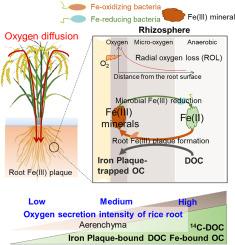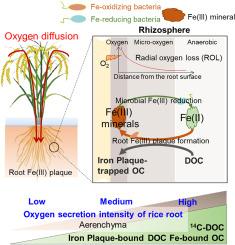Carbon stabilization by iron plaque on rice roots: The role of oxygen loss
IF 10.3
1区 农林科学
Q1 SOIL SCIENCE
引用次数: 0
Abstract
Radial oxygen loss (ROL) from rice roots plays a crucial role in iron plaque formation in paddy soils, which are regional hotspots for carbon accumulation and critical for climate change. While the role of soil oxygenation around rice roots is well-recognized for root functioning and nutrient uptake, the ROL effects on microbial communities and organic carbon (OC) stabilization remain largely unexplored. To address this gap, we combined soil zymography, 14C imaging, and planar optodes to investigate how ROL influences iron plaque formation and OC stabilization. We cultivated three rice varieties (Yangdao6, Nongken57, and Huanghuazhan) with contrasting ROL intensities. Among them, Huanghuazhan, a rice cultivar with greater aerenchyma, had higher oxygen loss than Yangdao6 and Nongken57. The increased ROL raised the OC content in the rhizosphere by trapping it within the iron plaque, with specific values of 1.26 ± 0.25 mg C g−1 root for Yangdao6, 3.22 ± 0.19 mg C g−1 for Nongken57, and 4.36 ± 0.34 mg C g−1 for Huanghuazhan. This increased iron plaque-trapped OC, in turn, raised Fe-bound OC content in the rhizosphere. The ROL increase reshaped rhizosphere microbiomes, driving synergistic proliferation of iron-oxidizing and iron-reducing bacteria that accelerated dynamic iron cycling by redox changes through Fe2+/Fe3+ oxidation/reduction. This self-reinforcing process amplified organo-mineral associations in reactive iron plaque, directly raising OC stabilization efficiency. Consequently, selecting rice varieties with larger ROL intensity could represent an effective strategy to increase OC stabilization in paddy soils. This study underscores the pivotal role of rice ROL for iron plaque formation and C sequestration, providing the first exploration of how ROL and aerenchyma percentage influence these processes in paddy soils.


水稻根系铁膜对碳的稳定作用:氧损失的作用
水稻根系径向氧损失(ROL)在水稻土铁斑块形成中起着至关重要的作用,水稻土是区域碳积累热点和气候变化的关键。虽然水稻根系周围的土壤氧化作用在根系功能和养分吸收方面的作用已经得到了广泛的认识,但ROL对微生物群落和有机碳(OC)稳定的影响在很大程度上仍未被探索。为了解决这一问题,我们结合土壤酶谱、14C成像和平面光电技术来研究ROL如何影响铁斑块的形成和OC的稳定。我们培育了3个水稻品种(扬稻6号、农垦57号和黄花占号),并对它们的ROL强度进行了对比。其中,气孔量较大的品种黄花站的耗氧量高于扬稻6号和农垦57。增加的ROL通过将OC捕获在铁斑块内,提高了根际OC含量,杨稻6号的比值为1.26±0.25 mg C g-1,农垦57的比值为3.22±0.19 mg C g-1,黄花站的比值为4.36±0.34 mg C g-1。这增加了铁斑块捕获的OC,反过来又提高了根际铁结合OC的含量。ROL增加了重塑的根际微生物群,推动了铁氧化和铁还原细菌的协同增殖,通过Fe2+/Fe3+氧化/还原的氧化还原变化加速了动态铁循环。这种自我强化过程放大了活性铁斑块中的有机-矿物质关联,直接提高了OC稳定效率。因此,选择ROL强度较大的水稻品种可能是提高水稻土有机碳稳定性的有效策略。本研究强调了水稻ROL在铁膜形成和碳封存中的关键作用,首次探索了水稻土壤中ROL和通气组织百分比如何影响这些过程。
本文章由计算机程序翻译,如有差异,请以英文原文为准。
求助全文
约1分钟内获得全文
求助全文
来源期刊

Soil Biology & Biochemistry
农林科学-土壤科学
CiteScore
16.90
自引率
9.30%
发文量
312
审稿时长
49 days
期刊介绍:
Soil Biology & Biochemistry publishes original research articles of international significance focusing on biological processes in soil and their applications to soil and environmental quality. Major topics include the ecology and biochemical processes of soil organisms, their effects on the environment, and interactions with plants. The journal also welcomes state-of-the-art reviews and discussions on contemporary research in soil biology and biochemistry.
 求助内容:
求助内容: 应助结果提醒方式:
应助结果提醒方式:


